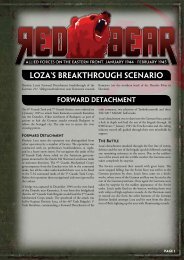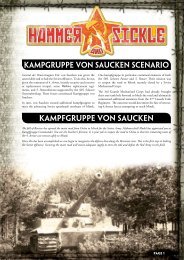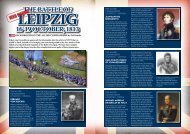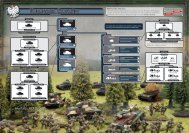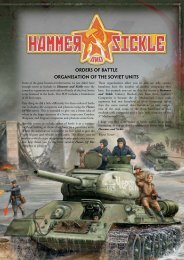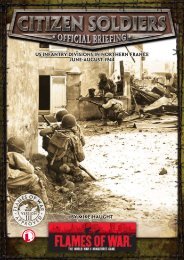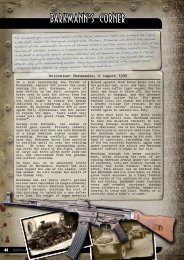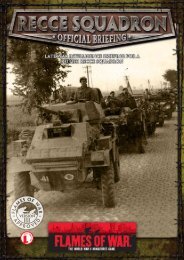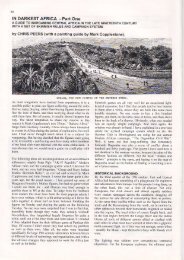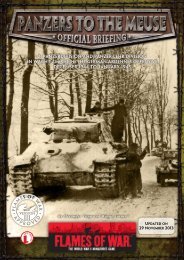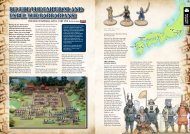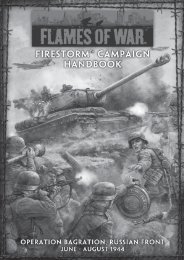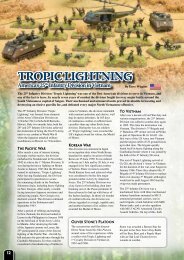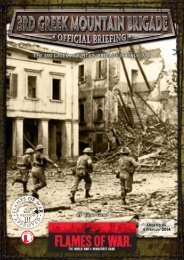Page - Flames of War
Page - Flames of War
Page - Flames of War
- No tags were found...
Create successful ePaper yourself
Turn your PDF publications into a flip-book with our unique Google optimized e-Paper software.
The Polish Home ArmyOn August 1, 1944, at about 5:00 pm, I heard machine-guns and grenades exploding. From my balcony at 28 Kopernika Street,I saw the attack on the [<strong>War</strong>saw] University. The boys positioned themselves along the street; the girls were delivering weapons andammunition.... The first days <strong>of</strong> the Uprising were successful, and we were given hope. Free <strong>War</strong>saw!- Sylwester Braun ‘Kris’, photographer during the <strong>War</strong>saw UprisingAfter Poland fell under the German war machine in 1939,the defeated troops immediately organised a resistancemovement. For many years the Polish partisans operatedagainst the Germans, launching small raids and makingcareful observations <strong>of</strong> the enemy force.All <strong>of</strong> the Polish resistance movements were consolidatedunder the Armia Krajowa, or Home Army, in February1942. From there the partisan strategy was to limit any <strong>of</strong>fensiveaction until such a time that a concerted effort couldbe made when the Germans were most vulnerable.In July 1943 General brygady (Brigadier General) Bór-Komorowski assumed command <strong>of</strong> the AK. Bór was a cavalry<strong>of</strong>ficer, having served in WWI in the Austro-Hungarian army.In 1939 he commanded the remnants <strong>of</strong> several cavalry unitsagainst the Soviets in eastern Poland. After the occupation <strong>of</strong>Poland, Bór joined the underground.Bór knew that the underground’s inexperienced soldierswouldn’t stand a chance in open combat against the Germansunless the Allies, in this case the Soviets, directly intervened.This was painfully obvious when the <strong>War</strong>saw Ghetto uprisingwas ruthlessly and absolutely crushed in 1943, with the loss<strong>of</strong> 60,000 Polish citizens.Bór’s other consideration was that the Soviets were hardlya preferable choice for allies. In 1939, Poland was invadedby both German and Soviet forces. As a result, the AK distrustedStalin’s intentions. It became critical, therefore, forthe Polish people themselves to overthrow the Germans andinstall their own free Polish government before Stalin couldput his own puppet government in control.The AK would have to wait for the arrival <strong>of</strong> the Soviet armyjust outside <strong>War</strong>saw before launching a full-scale insurrection,liberating themselves and then hopefully installing thefree Polish government exhiled in London.In June 1944 the Soviets launched Operation Bagration whichswept across Byelorussia like a wild fire. By the end <strong>of</strong> July theRed army was near <strong>War</strong>saw. After a false start the day before,Bór declared W-Hour (‘W’ for wybuch, or outbreak and als<strong>of</strong>or wolność, or freedom) at 1700 hours on 1 August.When W-Hour was announced, the undergroundAK battalions formed in the streets andallyways and then sprang into action, seizingimportant buildings and setting up barricades.However, not all the AK battalions managed tosecure their objectives straight away, The AKbattalions in Zolibórz were triggered too earlyand went into action against the well-defended<strong>War</strong>saw Citadel. The Germans rallied andlaunched an effective counterattack that forcedmany <strong>of</strong> the AK fighters in Zolibórz to retreatinto the Kampinos Forest to rally.Other pockets <strong>of</strong> German resistance were containedwithin buildings until the Kedyw arrivedto flush them out with heavy weapons.In the early hours <strong>of</strong> the rebellion a few Kedywunits ‘liberated’ a large quantity <strong>of</strong> Waffen-SSuniforms from a warehouse and incorporatedthem into their units.Other AK units used captured SS uniforms,but also managed to get a hold <strong>of</strong> all sorts<strong>of</strong> German and ex-Polish army uniforms.Wherever possible, AK troops attempted tomake themselves into a regular army usinguniforms, drill practice and <strong>of</strong>ficers.By the first few days the AK managed to securethe majority <strong>of</strong> its initial objectives.<strong>Page</strong>
The Germans had anticipated an uprising, however they completelyunderestimated its sheer scale. As a result the majority<strong>of</strong> the troops that bore the brunt <strong>of</strong> the Uprising were a fewscattered police units. Some <strong>of</strong> these managed to hold up inbuildings for some days, while others collapsed completely.Most <strong>of</strong> the German army was tied up in trying to containthe Soviet advance, so there was little that they could committo rapidly put down the rebellion, so the responsibility wasgiven to the Waffen-SS.The first German attacks were hastily organised and sent inwith little or no support. These were shattered against well organisedPolish defences and made little progress. The troopscommitted lacked much training and most were not at allhigh-quality fighters.The SS then implemented a harsh strategy, originating fromHitler himself to burn <strong>War</strong>saw to the ground, sparing not onecivilian. The western suburbs such as Wola suffered horriblyas German task forces rounded up and executed civilians andfighters alike. This galvanized the Polish against the Germanswho now knew what fate awaited them should they surrender—theywould fight to the death.The elite Kedyw, the AK’s veteran partisan fighters, used thetwo Panther tanks to great effect, helping to liberate a Jewishconcentration camp which held many <strong>of</strong> the survivors <strong>of</strong> theGhetto uprising the year before. Several hundred Jewish volunteersimmediately joined the AK upon being released.The fighting continued along the most <strong>of</strong> the perimeter as theGermans put pressure on the AK. Occasionally the Germanswould have some success in penetrating the line but usuallyat a high cost.As weeks passed, the beleaguered AK badly needed reinforcements.Bór, who was in constant contact with London,pleaded for the British to send the eager 1 st Polish IndependentParachute Brigade. However, Stalin refused to let Allied planesand troops destined to help the rebellion use Soviet bases and<strong>War</strong>saw was well out <strong>of</strong> range <strong>of</strong> Britain’s ability to deliver.However, the western Allies did send a few supply missions togive the AK some equipment including PIAT anti-tank projectors,Bren light machine-guns, rifles and ammunition. Aircrews, including some particularly brave Polish crews, madeseveral attempts to supply the besieged town, but in the endproved too costly and had to be stopped.Stalin refused to commit the 2 nd Tank Army which hadarrived outside Praga in September. His plan was to allow theGermans to completely crush the AK before moving in andestablishing his own government. However, under pressurefrom his western allies, he eventually sent a token force acrossthe Vistula River into <strong>War</strong>saw.The Soviet-controlled Ludowe Wojsko Polskie (LWP, or PolishPeople’s Army) crossed the Vistula on 15-19 September underterrible fire and air strikes, but those that made it across werewelcome reinforcements. However, without the support <strong>of</strong>the entire Soviet army the AK was reduced into small pocketbefore finally being reduced.General Bór ordered the final surrender on 2 October afterfighting for 63 days, the longest partisan battle in the war. TheAK had suffered 15,000 dead; about a third <strong>of</strong> its strength.The Germans lost 16,000 killed and 9,000 wounded, totallingapproximately half <strong>of</strong> its committed force.<strong>Page</strong>
Above: This photograph demonstrates further diversity in Polish AK uniforms and equipment. The solider to the left and right appears to be wearingGerman fieldgrey Panzer style jackets, while the one on the right has found a Waffen-SS smock.Also <strong>of</strong> note are their helmets. The man just right <strong>of</strong> the woman is wearing an Polish wz.31 helmet and the others have standard German helmets withWaffen-SS helmet covers.Above: AK troops don their new Waffen-SS uniforms.<strong>Page</strong>
Above: An AK-controlled 5cm PaK38 anti-tank gun. The crew is wearing full SS uniforms including trousers, boots, s<strong>of</strong>t caps, and jacket. The gun itselfappears to have been left in its original camouflage.Above: This heavy weapons squad is taking a break between missions. Again you can see the difference in the sorts <strong>of</strong> uniforms worn by AK soldiers. Theirtrousers and shirts are various colours and most likely a mix <strong>of</strong> civilian and military issue.They have also white eagles painted in white. The eagle insignia is based upon the Polish coat <strong>of</strong> arms. They have been painted very large to help in identificationand provide an interesting painting opportunity.<strong>Page</strong>
MODEL CHECKLIST FOR AN AK ARMYBuilding an AK army can be challenging and one <strong>of</strong> the mostdifficult tasks is sorting out which models you need for yourarmy. Below is a list <strong>of</strong> models you can use for your army sortedout by infantry, gun and vehicle teams.The AK’s variety <strong>of</strong> equipment <strong>of</strong>fers great modelling potential.For example, their heavy machine guns varied from Maksimguns to captured German ones. So modelling your heavymachine-gun platoon with both examples would help replicatethe hodge-podge nature <strong>of</strong> AK equipment.Infantry platoons also <strong>of</strong>fer excellent modelling opportunitieswhere you can pull figures from a great deal <strong>of</strong> sources for yourteams. You can be as creative as you like building an AK army!InfantryPolish Unit Model to Use Original Nationality Product CodeAK and Kedywinfantry & gun teamsSS-Panzergrenadierkompanie German GBX18AK and Kedywinfantry teamsSS-Panzergrenadier Platoon (Mid) German GE791AK mortar teams SS-Mortar Platoon (Late) German GE815AK, Kedyw, andPolish StrelkovyBattle Hardened Strelkovy Platoon Soviet SU802infantry teamsAK infantry Partisans & Polizei Soviet SBX09AK and Kedyw Flame-Thrower Platoon (late) Soviet SU737flame-thrower teamsGun teamsPolish Unit Model to Use Original Nationality Product CodeAK machine-gun teams Machine-Gun Company (late) Soviet SU734AK anti-tank gun teams 3.7cm PaK36 gun (x2) German GE501AK anti-tank gun teams 5cm PaK38 gun (x2) German GE510AK Artillery Battery Artillery Battery German GBX13AK Artillery Battery 10.5cm leFH18 howitzer (x2) (Late) German GE572Polish Strelkovy Company 45mm obr 1937 gun (x2) Soviet SU500Polish Strelkovy Company Mortar Company (late) Soviet SU735Polish Strelkovy Company Anti-tank Rifle Platoon (late) Soviet SU738VehiclesPolish Unit Model to Use Original Nationality Product CodeKedyw Assault Platoon Panzergrenadier Company HQ German GBX17Kedyw Tank Platoon Ernst Barkmann German GBX21Kedyw Tank Platoon Panther A German GE061Kedyw Tank Platoon Panzer IV H German GE046Kedyw Tank Platoon Hetzer German GE101Kedyw Tank Platoon Tiger I E (Zimmerit) German GE071Kedyw Armoured Car Platoon SdKfz 221 (MG) German GE300Be Creative!Remember, at its very core the AK army is ad-hoc. This gives you a great deal <strong>of</strong> latitude as you construct your force. Using allsorts <strong>of</strong> figures and bits from your collection will give the army a very different look from a normal <strong>Flames</strong> Of <strong>War</strong> force.<strong>Page</strong>
BUILDING AN ARMIA KRAJOWA ARMYIn order to make themselves look pr<strong>of</strong>essional the irregular troops the AK attempted to use a standard uniform wheneverpossible. A good portion <strong>of</strong> these were captured <strong>of</strong>f the Germans during the uprising. The SS uniforms captured on the firstday went a long way to adding a sense <strong>of</strong> uniformity to the AK. However, not all the troops had access to the uniforms andused whatever they had on their backs.Modelling AK InfantryThe AK’s mixture <strong>of</strong> uniforms can easily bereplicated using figures from several sources.When I began working on my AK army, Icollected some Waffen-SS, civilian, andSoviet figures.The bulk <strong>of</strong> my army will be sporting SS uniforms. For themost part I used the late-war Waffen-SS figures. Some oldveterans <strong>of</strong> the Polish Army wore captured SS tunics andtheir old army-issue brown trousers and black boots. Forthese troops, I used a few mid-war SSfigures.The SS-Panzergrenadierkompaniebox set (GBX18) is an ideal place tostart since it includes anti-tank guns,machine-guns and infantry—indeed,an entire AK army in a box!I started by picking out all <strong>of</strong> the figures armed with riflesand setting aside all the SMG and MG teams. The AK didn’thave many machine-guns at its disposal and those they didhave were organised into heavy machine-gun platoons.Soviet Rifleman with anSS head swapConvertedSS RiflemanThere were many submachine-gunsavailable as well, but these were largelyreserved for the assault troops. So I setaside most <strong>of</strong> the SMG miniatures forSMG teams.I also did several head-swaps throughoutthe whole force. The AK hadseveral varieties <strong>of</strong> headgear, rangingfrom Soviet, German and old Polish helmets, to s<strong>of</strong>t capsand berets. The old wz.31 model Polish helmet looks similarto the Soviet helmet, so I swapped several Soviet heads withGerman ones, being careful not to destroy them so I coulduse them later.Painting AK InfantryOnce I got all <strong>of</strong> the assembly things worked out, it was ontopainting—and lots <strong>of</strong> it! As demonstrated by the historicalphotos shown here the AK troops had a large variety <strong>of</strong>uniform colours.I made use <strong>of</strong> the Partisan & Polizeibox. Setting aside the Polizei foranother project, I used the Russian civiliansto augment the other Germanfigures i was using for AK troops.Painting civilian troops is rather funin that your paint selection is widenedPartisan Figure from thePartisans and Polizei beyond the usual camo tones tobox set include whites, blues, reds and otherbright colours.You can also convert military tunics into civilian ones just bychanging its colour. Civilian dress will yeild all sorts <strong>of</strong> colourcombinations if you think outsidethe box. I even found myself lookingup 1930s fashions on the internetand watching period movies to getinspiration for civilian clothing.I also painted the AK identificationarmband on each figure’s right arm,and a similar band around most <strong>of</strong>the German helmets.Soviet <strong>of</strong>ficer with aBritish Commandohead swapLeft & Below: The front and back <strong>of</strong> an AK rifle teamfrom my AK force. I intentionally went with three guyson the stand so that I could add more detail to the base.More on basing tips later.<strong>Page</strong>
When large numbers <strong>of</strong> helmets fell intoPolish hands, some AK squads painted thePolish eagle on them.On some <strong>of</strong> the figures’ helmets withoutcovers, I painted the Polish eagle emblem. Ipainted a very simple ‘V’ with a line downthe middle. Then, another small line at thebottom to simulate the eagle’s feet.Modelling KedywRifleman with aneagle emblem onthe helmetThe Kedyw were the elite troops <strong>of</strong> the AK.They were tasked with the most difficultassignments to secure critical buildings andlocations. To complete their mission, theyreceived a lot <strong>of</strong> the AK’s precious few heavyweapons.Heer Panzerfaust The Kedyw teams use the same equipmentfigure. withas the other AK teams, only they had manycivilian trousers.more submachine-guns and heavy weapons.The Waffen-SS figures are ideal for Kedyw platoons as theyused a significant portion <strong>of</strong> the captured uniforms. For myforce I used the SS figures for all <strong>of</strong> my Kedyw troops with afew head swaps here and there.Mid-war SS Figure (notethe jack boots)The most tricky <strong>of</strong> these would be theSS cam<strong>of</strong>lage smocks and trousers.The AK’s SS camouflage was in thePea Dot pattern, so I used JamesBrown’s excellent tutorial found inArt <strong>of</strong> <strong>War</strong> II: Wehrmacht Edition onpage 30. For some troops I paintedboth tunic and trousers in Pea Dot,while for others I mixed in a fewcivilian pants here and there.The Kedyw had a lot <strong>of</strong> hand-held anti-tank weapons aswell, ranging from PIAT projectors to Panzerfaust launchers.German Panzerfaust figures are perfect for Kedyw troops.PIAT teams are a bit more tricky, but <strong>of</strong>ten a head-swap witha British figure or two will suffice.Modelling ‘<strong>War</strong>saw’ BasesThe key feature <strong>of</strong> the <strong>War</strong>saw Uprising was, not surprisingly,the city itself. The terrain enabled the AK fighters to containGerman strongholds and force a fierce street-by-street fight.Urban bases can be a bit challenging, especially when youhave to cover a lot <strong>of</strong> bases in a large force. The secret is tokeep the bases simple enough in construction to repeat acrossa large force, yet <strong>of</strong>fer detail so as to not look too dull.For my force I focused largely on strewn rubble. I used copperwire for exposed plumbing, small squares <strong>of</strong> aluminum foilfor newspapers, balsa wood splinters for wood and assortedbits such as wagon wheels.However, there was a fair amount <strong>of</strong> fighting in non-urbanterrain such as parks, airfields, and forests so AK troops basedaccordingly would be just as accurate.The Stuff <strong>of</strong> BuildingsConsider how the building was built and what sorts <strong>of</strong>things would be exposed when it was destroyed, such asplumbing and timber frames. Was the building burned?Smoke and fire marks help tell the story <strong>of</strong> your building.For the exposed plumbing, I used copper wire and stuckseveral pipes close together, bent every which way. ThenI heavily washed them with watered-down black andbrown paint to take some <strong>of</strong> the shine <strong>of</strong>f the wire. Thematt varnish at the end helps tie it into the base.Fabric & PaperIn the example shown here, the disgraced flag andcrumpled newspaper are made from aluminum foil.Cut the foil to the right size, put some glue on the backside and set it on the base. Then take a stiff-bristled paintbrush and press it into the base so that the foil takes onthe shape <strong>of</strong> the texture underneath.<strong>Page</strong> 10
Urban Basing TheoryMy theory <strong>of</strong> basing is that bases should set the scene for thestory your army tells. Sometimes that scene is simple, likea late-spring pasture or a winter wonderland. Or, they canbe complex, like urban basing. In the end basing is just asimportant (if not more) to me as the figures themselves.For my <strong>War</strong>saw force, rather than just making randomurban bases, I carefully thought about the scene and howand where each platoon in the force fit. Photographs reallyhelped at this stage.For example, anti-tank guns will be in the street with improvisedcover around them. The infantry will be found intrickier terrain such as a destroyed building. But overall,these platoons are found near each other and thus similarrubble and wreckage will be found on each base.Though a neat effect, bases don’t have to be inter-connectingas if it were a puzzle. They just have to look as though theyconnect, and having a scene established in your head is agreat way to make sure you don’t deviate and end up with arandom assortment <strong>of</strong> urban bases.When working on rubble from a ruined building, it reallyhelps to know ahead <strong>of</strong> time what your building looked likebefore and after it was destroyed, even if you aren’t modellingthe whole building. Basically, you want to know howthe building lived, and how it died.For example, if your troops will be fighting in and arounda department store, think about the colour <strong>of</strong> the buildingand decorative architecture, such as fascades and cast-ironembellishments.Also think about what was inside. Was it looted? Was it fullystocked? Is there anything inside that the civilians wouldhave pulled out to make barricades?In the example here I wanted to focus on the corner <strong>of</strong> anabandoned German HQ building (though you probablycan’t easily see it now!). This helps make the stand ‘makesense’ and scenic.For rubble I used several sizes <strong>of</strong> model railway ballast.Mixing small and medium grains help vary the size <strong>of</strong> therubble so that it doesn’t look like the building collapsed intidy, uniform, easy-to-clean bits.When painting rubble remember the colour you chose forthe building. The bricks or stone blocks would be paintedon one side. I base coated all my rubble in a brick-colouredred-brown to simulate bricks. I then painted several lightgrey (the colour I chose for the exterior <strong>of</strong> my building).Rubble isn’t clean either. When a building collapses a goodportion <strong>of</strong> the material is pulverised into dust and grit. Atthe end <strong>of</strong> the painting process, I dry-brushed the rubblewith brick red and shades <strong>of</strong> khaki.Then add ambient wreckage, from wood splinters, exposedplumbing, wall paper, recruiting posters, graffiti, and more.Below: Brokenbrick andpulverised dustLeft: Exposedplumbing andshattered timberRight: Ambientwreckage andlitter, such asnewspapers andrecruiting postersModelling a BarricadeBefore I started modelling, I found several pictures from theuprising to see what sorts <strong>of</strong> things would be used in the barricadeand found that it was pretty much anything the troopscould haul into the streets such as overturned automobiles,bricks rubble, timber, bed frames, furniture, etc..Barricades are Barrier fortifications which makes them8”/20cm long and 2”/5cm deep. For this project, I’ve splitthe barricade into two 4”/10cm x 2”/5cm sections so thatthey can fit between buildings on narrow streets or put themside-by-side in larger areas.Zis-5 3-tontruck (SU422)ModelRailroad RodIron PiecesThe barricades need to be big enough to stop vehicles so Imade sure that the barricade topped about 1”/2.5cm. I useda few model railroading bits for the cast-iron pieces and someextra pieces in my spare parts drawers for rest.Ages ago I dropped an old soviet truck and the resin broke,so I weathered it and stuck it on the base as well, concealingthe base with rubble. I used some Schürzen pieces and somematch sticks for lumber. Some barricades were manned, soyou can put some troops on them as well for aesthetic value.ModelRailroad RockBallastCartStaff TeamTableAmmo BoxesSchurzenPlatesWagonWheelsStatic RocketLauncherframeSpare TyreMatch-StickLumber55-GallonBarrel<strong>Page</strong> 11
Modelling VehiclesThe AK captured several armoured vehicles during theUprising including two Panthers, a Tiger, a Panzer IV, aHetzer and some armoured cars. These were left in theoriginal colours that they were captured in. The AK paintedlarge Polish symbols all over the tank, including Polish flags,eagles and other such nationalistic markings. They werepainted oversized so that they could not be mistaken forGerman tanks.A common marking was ‘WP’ which stood for Wojsko Polskie(Polish Army). This originated from the Polish undergroundflag which itself was also commonly found painted on Polishvehicles during the uprising.The AK also constructed a few examples <strong>of</strong> their ownarmoured transports, including Kubus, a converted 3-tonChevorlet truck. These were <strong>of</strong>ten just painted in whatevercolour was handy.The exception to this was ‘Kubus’ which was specificallypainted in camouflage because it was too valuable to riskgetting knocking it out. The camouflage scheme was a series<strong>of</strong> dark grey streaks over an overall medium-grey basecoat,which helped the vehicle blend into the urban terrain.Left: Barkmann’s Panther model(GBX21) provided me with an openturret hatch so I could model thescene photographed above.Above: A Kedyw Panther tank crew pause to plan their next move.Modelling AK VehiclesPainting AK vehicles is quite simple. Basically,paint them as though they are German and thenpaint Polish markings all over it.There are numerous pictures <strong>of</strong> an AK Panthertank which appears to have no discolouration thatone would expect from a camouflaged vehicle,indicating that it was painted in standard darkyellow (Middlestone 882).As you can see from the photo above the GermanBalkenkreuz was not painted over and was stillvisible.The crews painted several Polish flags and insigniaall around the turret and hull to help identify thevehicle. Inspirational and patriotic slogans andother such graffiti were also applied to vehiclesSome half-tracks and tanks also received the Polish‘checkerboard’ insignia. This was first used as apersonal insignia <strong>of</strong> the Polish fighter pilot StefanStec during World <strong>War</strong> I and was eventuallyadopted as the Polish national symbol in 1918.There are several examples <strong>of</strong> this symbol beingused in <strong>War</strong>saw.Above: A captured Sd Kfz 251 half-track with the Polish checkerboard insignia.<strong>Page</strong> 12
Batalion Armii Krajowej Special RulesThe Armia Krajowa (Home Army, known simply as the AK) was both cunning and resourceful during the <strong>War</strong>saw Uprisingto contend with an enemy that was superior in both training and equipment. They called on ex-weaponsmiths, mechanics andother skilled labour to build much <strong>of</strong> their stockpile <strong>of</strong> weapons and raised many Batalion Armii Krajowej (AK Battalions).Home-built WeaponsDespite no shortage in manpower, the AK was critically lowon weapons while it built up its arsenal. So they employedex-weaponsmiths, mechanics and other skilled labour tobuild more weapons and vehicles.Weapons that are listed in the Arsenal as Home-built areliable to explode with deadly result.Each time a Home-built weapon shoots, roll a die for eachHome-built weapon after its platoon has resolved all <strong>of</strong> itsshooting:• On a roll <strong>of</strong> 1 the team shooting the Home-built weaponis Destroyed.• Otherwise, the weapon holds up and the team is notDestroyed.For example, when a Home-built Flame-thrower rolls a 1the Flame-thrower team is Destroyed rather than removedfrom play after it is done shooting.Battalions <strong>of</strong> the UprisingAlthough the AK was organised into companies, they foughttogether as battalions under a single leader.A Batalionowy Armia Krajowa uses the Soviet CentralisedControl special rule found on page 142 <strong>of</strong> the rulebook.Tunnels and PathsBefore the Uprising, the AK mapped out <strong>War</strong>saw’s sewersand concealed passageways and trained scouts so that whenthe time came AK troops could use them to maneuver pastGerman strongpoints.Infantry and Man-packed Gun teams from Combat andWeapons Companies and the Kedyw Assault Platoon treatrubble and woods as Cross-country Terrain, allowing themto move At The Double.For Your Freedom and oursThe Poles fought with remarkable bravery in combat. Theysecured their objectives and made the enemy pay dearly toclaim it back.Polish Companies and Platoons may re-roll failed PlatoonMorale Checks.If you are fielding a Polish Company, your CompanyCommand team may re-roll failed Company MoraleChecks.Barricades Special RulesThe Armia Krajowa established hundreds <strong>of</strong> barricades throughout the city, turning them into death traps as the Germanstried to clear them. Snipers, explosives and heavy machine-guns defended these choke points.A force based on a Batalion Armii Krajowej may include up to five barricades for +50 points each. A barricade is a Barrierfortification (see page 209 <strong>of</strong> the <strong>Flames</strong> Of <strong>War</strong> rule book). Barricades must be deployed anywhere in No-mans-land or inyour deployment area immediately before any objectives are placed.Crossing a BarricadeBarricades are Very Difficult Going, but are Impassableto Cavalry and teams with Remote Control DemolitionCarriers. This means that only troops on foot and Fullytrackedarmoured vehicles can cross them at all, althoughFully-tracked vehicles need a Skill test to do so. Overloadedvehicles must re-roll successful Skill tests to cross abarricade.A barricade is built high and deep so teams must start theirmovement adjacent to the barricade to cross it, and muststop their movement on reaching a barricade.Teams cannot end a Step sitting on a barricade. They mustbe on one side or the other and clearly either adjacent to thebarricade or back from it.Taking Cover behind a BarricadeBarricades provide Concealment and Bulletpro<strong>of</strong> Coveragainst shooting from the other side, but no protectionagainst artillery fire, or aircraft.Gapping a BarricadeA Remote-Controlled Demolition Carrier (see page 216 <strong>of</strong>the rulebook) detonated adjacent to a barrier that makes asuccessful Firepower Test using its second firepower rating,creates a 2”/5cm wide gap that is Difficult Going<strong>Page</strong> 13
BATALION ARMII KRAJOWEJ(Home Army Battalion)(Infantry Company)Combat Companies HeadquartersCompany HQCompany HQInfantryAK Infantry CompanyInfantry1515An Batalion Armii Krajowej must field a Company HQ and one AK Infantry Company and up tothree additional AK Infantry Companies and a Kedyw Company and one Kedyw Company.It may also field one <strong>of</strong> each <strong>of</strong> the Weapons Platoons shown and one Support Platoon from eachSupport box shown (Armoured, Infantry, etc.).Weapons CompaniesArtilleryAK Mortar CompanyMachine-guns16Support PlatoonsArmourInfantryKedyw Tank PlatoonKedyw Armoured Car PlatoonKedyw Assault Platoon181819AK Machine-gunCompany17Polish Strelkovy Company20AK Infantry Company15Anti-tankArtilleryInfantryAK Anti-tank Platoon17AK Artillery Battery19AK Infantry Company15InfantryAK Infantry Company15InfantryKedyw Company16<strong>Page</strong> 14
Motivation and SkillHitler’s orders to German troops in <strong>War</strong>saw was to give no quarter and to level the city. The Polish witnessed these ordersbeing executed and were under no illusion what fate awaited them should they surrender. As a result the civilian fighters<strong>of</strong> the Armia Krajowa were even more motivated and fought to the last man and woman.A Batalion Armii Krajowej is rated Fearless Conscript.Company HQHeadquartersHeadquartersBattalion HQ20 pointsPodpulkownikPodpulkownikOption• Replace either or both Command Rifle Teams withCommand Panzerfaust SMG teams for +10 pointsper team.• Add up to three Sniper teams for +50 points perteam.Company CommandRifle teamCompany HQ2iC CommandRifle teamBatalionowy Armia KrajowaCombat CompaniesAK Infantry CompanyCompanyHQ Section with:4 Rifle Platoons 215 points3 Rifle Platoons 165 points2 Rifle Platoons 110 pointsKapitanKapitanOptions• Replace up to one Rifle team with a PIAT team atno cost.• Replace all Rifle teams in up to two Rifle Platoonswith SMG teams for +25 points per Rifle Platoon.• Replace all Rifle teams in up to one Rifle Platoonwith Pioneer Rifle teams for +25 points.PorucznikRifle teamRifle team Rifle teamPorucznikRifle teamRifle team Rifle teamYou may replace up to one Rifle team with a Flame-throwerteam at the start <strong>of</strong> the game before deployment.The Armia Krajowa (Home Army) had been planning forthe <strong>War</strong>saw Uprising since 1941. However, its leaders wiselyrealised that they would have to wait until Germany was atits weakest point before launching the insurrection.Until then, districts were formed within the city, each withseveral battalions <strong>of</strong> AK troops ready to fight at moment’snotice. They trained in secret, horded guns and opened upsecret workshops to build weapons including submachineguns,mortars, and flame-throwers.When the Uprising began, thousands <strong>of</strong> AK troops assembledand went into action. Their equipment varied, dependingon what their district had in its arsenal at the time <strong>of</strong> theuprising. Many battalions went into action unarmed, savefor some melee weapons, intent on acquiring some <strong>of</strong>f theirdefeated foes.Rifle teamRifle teamRifle PlatoonRifle teamRifle teamPorucznikRifle teamRifle teamRifle teamRifle PlatoonRifle teamAK Infantry CompanyRifle teamRifle PlatoonRifle teamRifle teamPorucznikRifle teamRifle teamRifle teamRifle PlatoonThe battalions fought with intense bravery and refused tosurrender, despite increasingly difficult circumstances. Thetroops were determined to establish a free Polish state, orgive their lives honourably in the noble effort.<strong>Page</strong> 15
Kedyw CompanyCompanyHQ Section with:2 SMG Platoons 175 points1 SMG Platoon 95 pointsOptions• Replace Command SMG team with a CommandPanzerfaust SMG team for +10 points. If you dothis, you may replace all remaining SMG teams withPanzerfaust SMG teams for +10 points per team• Equip all SMG teams with Gammon Bombs for+15 points per SMG Platoon.• Add up to two PIAT teams to the HQ Section for+15 points per team.A Kedyw Company is rated Fearless Trained.You may replace up to one SMG team with a Flame-throwerteam at the start <strong>of</strong> the game before deployment.The KedywDuring the occupation, the Kedyw conducted a long partisanwar against the Germans. They horded the weapons andsupplies they had collected after successful ambushes andraids and buried and hid them in stashes inside and out <strong>of</strong><strong>War</strong>saw.When ‘W’ Hour signalled the beginning <strong>of</strong> the <strong>War</strong>sawUprising, the Kedyw assembled in the Old Town District.Local AK units were already rising up and capturing the fewlightly defended objectives.However, once the word got out to the German defendersthat the Uprising was in full swing, they fortified themselvesinto important buildings across the city. Local AK units wereSMG teamSMG teamCommandSMG teamPorucznikSMG teamSMG teamSMG PlatoonKapitanKapitanPIAT team PIAT teamSMG teamSMG teamKedyw CompanyPorucznikSMG teamSMG teamSMG PlatoonThe Kedyw were an elite unit in the AK. They had beenfighting the Germans since 1940 as an underground formationconducting sabotage and ambushes. As a result theyaccumulated a lot <strong>of</strong> experience fighting the Germans andwere ready for their role in the uprising.unable to contest these strong points, despite their braveefforts, so the combat-experienced Kedyw went to work.The Kedyw was held in reserve under cental control. OnceGerman stongholds could be identified, they would be sentout to reduce the defenders and capture the building.Group Radoslaw and Battalion Kilinski both made significantcontributions to the AK. Radoslaw captured the AK’sfirst armoured vehicles and used them to liberate a Jewishprisoner camp. Battalion Kilinski used flame-throwersand close combat to capture <strong>War</strong>saw’s tallest building, thePrudential Building.Weapons CompaniesAK Mortar CompanyCompanyHQ Section with:6 Captured 8cm GW34 105 points3 Captured 8cm GW34 65 points6 Home-built 8cm 80 points3 Home-built 8cm 40 pointsPorucznikPorucznikThe Polish Home Army needed artillery so they could pindown the German defenders. When the Uprising began theyhad a large collection <strong>of</strong> home-built mortars made fromsalvaged materials. They horded stolen ammunition andprepared for when it would be needed.SierzantMortar MortarMortarSierzantMortar MortarMortarOnce the Uprising was in full swing, AK troops began acquiringcaptured German mortars to replace their own lessreliable ones.Mortar PlatoonAK Mortar CompanyMortar Platoon<strong>Page</strong> 16
AK Machine-gun CompanyCompanyHQ Section with:2 Machine-gun Platoons 145 points1 Machine-gun Platoons 75 pointsPorucznikPorucznikAn AK Machine-gun Platoon may make CombatAttachments to Combat Platoons.MG42 HMGSierzantMG42 HMGMG42 HMGSierzantMG42 HMGInitially, the AK had a small number <strong>of</strong> machine guns availableto them. Soon after the fighting began they collected manymore machine-guns from the Germans including MG34and MG42 and Soviet Maksim heavy machine-guns.MG42 HMGMachine-gunPlatoonMG42 HMGMachine-gunPlatoonAK Machine-gun CompanyAK Anti-tank Gun CompanyPorucznikCompanyHQ Section with:3 3.7cm PaK36 65 points2 3.7cm PaK36 45 points3 5cm PaK38 70 points2 5cm PaK38 50 points2 7.5cm PaK40 85 pointsOption• All 3.7cm PaK guns are equipped with Steilgranateammunition at no cost.SierzantAnti-tank gunAnti-tankPlatoonPorucznikSierzantAnti-tank gunAnti-tankPlatoonAn AK Anti-tank Gun Platoon may make CombatAttachments to Combat Platoons.As the AK swept through the city, they recovered several antitankguns and put them to use in their battalions, keepingGerman raids using light vehicle at bay.SierzantAnti-tank gunAnti-tankPlatoonAK Anti-tank Gun Company<strong>Page</strong> 17
Motivation and SkillSupport PlatoonsThe AK used its best troops to assault difficult positions and man its limited armoured fighting vehicles.The support platoons <strong>of</strong> a Batalionowy Armia Krajowa are exceptions to the Centralised Control special rule. They operate asnormal platoons. They are rated Fearless Trained.Kedyw Tank PlatoonPlatoon2 Panther A 220 points1 Panther A 110 points1 Tiger IE 120 points1 Panzer IV H 60 points1 Hetzer 55 pointsWithin the first few days <strong>of</strong> the Uprising, Battalion Zoskacaptured two Panther tanks and used them in an assault t<strong>of</strong>ree Jewish prisoners from the Gesiówka prison camp.In the Ochota district, Battalion Gustaw captured a Panzerand a Tiger in 4 August. Both were pressed into service butwere both destroyed the same day.PorucznikCommandCaptured tankHQ SectionPorucznikKedyw Tank PlatoonSierzantCaptured tankCaptured TankBattalion Kilinski captured a Hetzer and two armoured carsusing Molotov cocktails during the early fighting in the OldTown. Although the Hezter was badly damaged in the attack,the AK managed to get it up running again.Kedyw Armoured Car PlatoonPorucznikPlatoon2 Captured Sd Kfz 221 (MG) 60 pointsPorucznikSierzantThe Polish insurgents captured two armoured cars alongwith a Hetzer in the Old Town district and quickly pressedthem into service.Command CapturedSd Kfz 221HQ SectionCapturedSd Kfz 221Armoured CarKedyw Armoured Car Platoon<strong>Page</strong> 18
Kedyw Assault PlatoonPlatoonHQ Section with:1 Assault Squad 150 pointsNo Assault Squad75 pointsOptions• Replace a Captured Sd Kfz 251/1 half-track with‘Kubus’ armoured car for +25 points.• Replace the MG on ‘Kubus’ with a PIAT at no cost.All SMG teams in the Kedyw Assault Platoon carryGammon Bombs, giving them Tank Assault 3.Group Krybar led the attack on the German garrison at the<strong>War</strong>saw University. The assault group used a captured Germanhalf-track christened ‘Szary Wilk’ and the home-builtarmoured car ‘Kubus’ to form an armoured infantry platoon.PorucznikCommandSMG teamCaptured PIAT teamSd Kfz 251/1HQ SectionPorucznikSierzantSMG team SMG team SMG teamKedyw Assault PlatoonCaptured PIAT teamSd Kfz 251/1Assault SquadAn Kedyw Assault Platoon may use the Mounted Assaultspecial rule found on page 137 <strong>of</strong> the rulebook.Fully equipped with the latest Allied supply drop <strong>of</strong> Gammonbombs and PIATs, the assault platoon went into action againstthe Germans on several successful missions..‘Kubus’The AK needed an armoured fighting vehicle to help break the stalemateagainst the dug in German Sicherung company at the <strong>War</strong>sawUniversity. So, Polish engineers went to work collecting steel platesfrom all around the city as well as an old 3-ton Chevrolet truck.As the armoured car began to take shape, the wife <strong>of</strong> the lead engineer,a doctor known by the resistance as ‘Kubus’, was killed on 15 August.The armoured car was named after the fallen heroine and soon wentinto action against the Germans.‘Kubus’ was armed with a Soviet 7.62mm DP Model 1928 machinegunand a flame-thrower and was designed as an armoured personneltransport, carrying a squad <strong>of</strong> 12 men.‘Kubus’ was abandoned after the fall <strong>of</strong> Powisle and has since beenrestored and put on display in the Muzeum Wojska Polskiego (Museum<strong>of</strong> the Polish Army) in <strong>War</strong>saw.AK Artillery BatteryCompanyHQ Section with:6 Captured 10.5cm leFH 190 points3 Captured 10.5cm leFH 100 pointsCommandRifle teamStaff teamObserverRifle teamOption• Add an Observer Rifle team for +15 points.The AK Artillery Battery was manned by untrained personnel.An AK Artillery Battery is rated Fearless Conscript.Captured10.5cm leFH18Captured10.5cm leFH18By the end <strong>of</strong> the first day <strong>of</strong> fighting the AK had captured sixhowitzers, seven mortars, two anti-tank guns, 27 Panzerfaustanti-tank launchers, 70 machine-guns, 373 rifles and103 pistols.The six howitzers were centralised and put to use where everartillery was needed most. An Observer team scrounged forradio sets to use and eventually got one running.Captured10.5cm leFH18Captured10.5cm leFH18AK Artillery BatteryCaptured10.5cm leFH18Captured10.5cm leFH18<strong>Page</strong> 19
Polish Strelkovy CompanyCompanyHQ Section with:2 Rifle Platoons 270 points1 Rifle Platoon 145 pointsOptions• Add Maksim HMG teams for +25 points per team.• Add Mortar Platoon for +55 points.• Add Anti-tank Rifle Platoon for +25 points.• Replace all PTRD Anti-tank Rifle teams with 45mmobr 1942 anti-tank guns for +20 points.• Replace all Rifle/MG teams in one Rifle Platoonwith SMG teams at no cost.Rifle/MG teamKAPITANCommandRifle/MG teamHQ SectionLEYTENANTRifle/MG teamRifle/MG teamKAPITANSerzhantMaksim HMGMaksim HMGMachine-gunPlatoonRifle/MG teamLEYTENANTRifle/MG teamRifle/MG teamA Polish Strelkovy Company is a Soviet company and usesall <strong>of</strong> the Soviet special rules found on pages 180-182rulebook as well as the For Your Freedom and Ours specialrule found on page 5 <strong>of</strong> this briefing.Rifle/MG team Rifle/MG teamRifle/MG team Rifle/MG teamRifle PlatoonRifle/MG team Rifle/MG teamRifle/MG team Rifle/MG teamRifle PlatoonThe Soviet army reached the Vistula on 14 September. In itsranks was the Ludowe Wojsko Polskie (Polish People’s Army)which was understandably anxious to liberate <strong>War</strong>saw.However, Stalin ordered the Red Army to halt on the river.Communications from the AK were deliberately ignored—the Soviet war machine fell silent for two long days.Finally, the Polish army was given the green light to cross theVistula and three divisions were sent over into <strong>War</strong>saw. Inthe Czerniakow district, 300 troops from the 3rd InfantryDivision crossed the river bringing with them machine-guns,anti-tank guns, and mortars.The badly needed reinforcements bolstered the AK GroupRadoslaw. However, again the Soviets did not commit itsartillery or aircraft to assist the uprising.Three divisions headed into <strong>War</strong>saw, however only 1500troops made it across the river, the rest being cut <strong>of</strong>f by theGermans and destroyed piecemeal on the river banks.LEYTENANTPTRDAnti-tank RiflePTRDAnti-tank RifleAnti-tankrifle platoonLEYTENANT82-BM-41 mortar82-BM-41mortarPolish strelkovy Company82-BM-41mortarMortar platoonThe remaining Polish troops and equipment were absorbedinto local AK regiments. Meanwhile, the Soviet army waitedquietly on the opposite river bank and the Polish capitalremained in German control until January 1945.<strong>Page</strong> 20
AK Battalions in the <strong>War</strong>saw UprisingThe city <strong>of</strong> <strong>War</strong>saw was split into several major districts:the Old Town, the City Centre, Zolibórz, Kaminos Forest,Wola, Ochota, Mokotów, Powisle, Praga, and Okecie. Othersmaller districts that fell outside <strong>of</strong> the city were referred toas Greater <strong>War</strong>saw.Each district was then divided into sections each defendedby several AK battalions. The elite Kedyw units were notassigned to any specific location and were instead held as amobile reserve that would be dispatched to handle troublespots once the Uprising began.Each AK battalion usually consisted <strong>of</strong> two to six companies<strong>of</strong> about 100 soldiers. At W-Hour the companies assembledand each fighter was issued a white and red armband toidentify them as AK soldiers.When the uprising kicked <strong>of</strong>f many <strong>of</strong> the AK troops didn’thave weapons and had to rely on capturing or securing themfrom the Germans or fallen comrades.Home-made weapons supplemented the lack <strong>of</strong> guns andmortars. These were initially made in secret workshops. Oncethe uprising began the AK set up a workshop for producingand repairing weapons for the rebellion.What limited defensive weapons the AK had at its disposal,such as the heavy machine-guns, mortars and artillery wereallocated to the AK battalions and not the Kedyw to bulk updefensive positions.In contrast, the Kedyw units were well equipped andsufficiently experienced with <strong>of</strong>fensive weapons. They heldthe bulk <strong>of</strong> the AK’s submachine-guns and flame-throwers.Captured vehicles were also operated by the Kedyw whichput the precious tanks under the command <strong>of</strong> relatively experiencedtank crews.The Kedyw battalions fought as a fire brigade, reinforcingwhatever part <strong>of</strong> the line the AK either planned to launch an<strong>of</strong>fensive, or expected a serious German counterattack.WARSAW 1944AK DistrictWolaZmijaMiles1AK UnitRadoslawZoliborzZubrWilson SquareKilometres2Major FightWilson SquareKampinosZniwiarzZbik<strong>War</strong>sawCitadelKampinos Forest8mi/13kmZyrafaZaglowiecBtn GrunwaldPragaSoviet 3 rd Tank Corps8mi/13kmUmschlagplatzRail YardRadoslawChrobry IIOld TownBielanksa StBankKuba-SosnaKierbedziaBridgeBtn OlszynaBtn BolekPraga RailroadHead OfficeGurtLesnikAK HQKammlerFactoryNorth Sec.City CentreKrybarPowisleElectricalPower PlantBtn PlaterwekWolaBtn SowinskiRogPrudentialBuildingBtn Kilinski<strong>War</strong>sawUniversityCzerniakówPoniatowskiBridgeWest Sec.WolaOkecie AirfieldGarluch3mi/5kmSS-PolizeiBarracksBtn GustawOkecie AirfieldBtn WaclawaOchotaGestapoHeadquartersJelenBasztaGrzmalySt ElizabethHospitalMokotów<strong>Page</strong> 21
BATALIONOWY ARMIA KRAJOWA ARSENALTANK TEAMSArmourName Mobility Front Side Top Equipment and NotesWeapon Range ROF Anti-tank FirepowerTanksPanzer IV Fully-tracked 6 3 1 Co-ax MG, Hull MG, Protected Ammo, Schürzen,Unreliable.7.5cm KwK40 gun 32”/80cm 1 11 3+Panther A Fully-tracked 10 5 1 Co-ax MG, Hull MG, Wide Tracks, Unreliable.7.5cm Kwk42 gun 32”/80cm 1 14 3+Tiger IE Fully-tracked 9 8 2 Co-ax MG, Hull MG, Protected Ammo, Slow tank,Wide tracks, Unreliable.8.8cm KwK36 gun 40”/100cm 1 13 3+ Slow Traverse.Hetzer Fully-tracked 7 2 1 Hull MG, Overloaded, Unreliable.7.5cm PaK39 gun 32”/80cm 1 11 3+ Hull mounted.Armoured CarsSd Kfz 221 (MG) Wheeled 1 0 0 AA MG, Unreliable.Vehicle Machine-gunsVehicle MG 16”/40cm 3 2 6 ROF 1 if other weapons fire.GUN TEAMSWeapon Mobility Range ROF Anti-tank Firepower NotesPTRD anti-tank rifle Man-packed 16”/40cm 2 5 5+ Tank Assault 3.MG34, MG42 or Maksim HMG Man-packed 24”/60cm 6 2 6 ROF 2 when pinned down.Home-built 81mm mortar Man-packed 32”/80cm - 2 6 Home-built.8cm GW34 mortar Man-packed 40”/100cm - 2 6 Smoke bombardment.82-BM-41 mortar Man-packed 40”/100cm - 2 63.7cm PaK36 gun Light 24”/60cm 3 6 4+ Gun shield.Firing Stielgranate 8”/20cm 1 12 5+45mm obr 1942 gun Light 24”/60cm 3 8 4+ Gun shield.5cm PaK38 gun Medium 24”/60cm 3 9 4+ Gun shield.7.5cm PaK40 gun Medium 32”/80cm 2 12 3+ Gun shield.10.5cm leFH18 howitzer Immobile 24”/60cm 1 10 2+ Gun shield, Smoke.Firing bombardments 75”/180cm - 4 4+ Smoke bombardment.<strong>Page</strong> 22
Team Range ROF Anti-tank Firepower NotesRifle team 16”/40cm 1 2 6Rifle/MG team 16”/40cm 2 2 6SMG team 4”/10cm 3 1 6 Full ROF when moving.Bazooka or PIAT team 8”/20cm 1 10 5+ Tank assault 4.Flame-thrower team 4”/10cm 4 - 6 Flame-thrower. Home-built.Staff team cannot shoot Moves as a Heavy Gun team.Additional Training and EquipmentINFANTRY TEAMSPanzerfaust 4”/10cm 1 12 5 Tank Assault 6, Cannot shoot in the Shooting Step if moved inthe Movement Step.Pioneer teams are rated as Tank Assault 4. Teams with Gammon Bombs are rated as Tank Assault 3.ArmourName Mobility Front Side Top Equipment and NotesWeapon Range ROF Anti-tank FirepowerArmoured Personnel CarriersTRANSPORT TEAMSSd Kfz 251/1 half-track Half-tracked 1 0 0 Hull MG, Passenger-fired AAMG, Unreliable.‘Kubus’ Wheeled 1 0 0 Co-ax MG, Overloaded, Unreliable.Home-built Flame-thrower 4”/10cm 3 - 6+ Flamethrower, Home-built.Above: An AK soldier armed with a home-built flame-thrower. Hundreds <strong>of</strong> these uncomfortably unreliable weapons were constructed in secret workshopsall across <strong>War</strong>saw before the uprising began.<strong>Page</strong> 23



